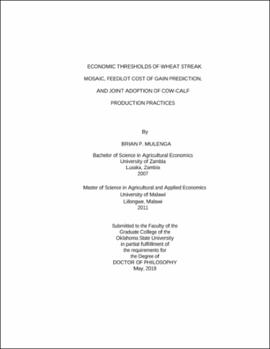| dc.contributor.advisor | Raper, Kellie | |
| dc.contributor.author | Mulenga, Brian P. | |
| dc.date.accessioned | 2023-08-21T19:42:39Z | |
| dc.date.available | 2023-08-21T19:42:39Z | |
| dc.date.issued | 2019-05 | |
| dc.identifier.uri | https://hdl.handle.net/11244/338892 | |
| dc.description.abstract | Wheat streak mosaic (WSM), caused by Wheat streak mosaic virus, which is transmitted by the wheat curl mite (Aceria tosichella Keifer), is the most widespread and economically important virus disease affecting winter wheat in the Great Plains of the United States. Because there is no curative treatment, the disease can lead to significant yield loss, rendering continuation of mid-season input application uneconomical. This dissertation determines three economic thresholds for WSM beyond which further input applications become uneconomical. Results show varying thresholds depending on the date of disease severity assessments. Results indicate potential to save resources by discontinuing mid-season input applications and introducing cattle for grazing, in about 14% of the sampled plots. | |
| dc.description.abstract | Feedlots use cost of gain (COG) to evaluate the tradeoff between purchasing heavier feeders or lighter feeders. Typically, ex-post COG for the feeding period just finished is used as a naïve projection for future closeout. However, such a naïve estimate may mask the effect of varying corn price and seasonality of cattle feeding efficiency on COG. This dissertation constructs an ex-ante COG prediction model to help facilitate more accurate estimation of expected COG, and thus corresponding feedlot purchase breakeven price, for lighter animals relative to heavier animals (800-850 pounds). Results show that the constructed model predicts COG more accurately than the naïve model. Results also show small reduction in price spreads between feeder market price and breakeven price for lighter weights when the predicted COG is used in calculating the breakeven price. | |
| dc.description.abstract | Existing studies on adoption of cow-calf management practices tend to treat practices individually and by implication ignore the possibility that some practices are more likely to be jointly adopted. This dissertation uses market basket analysis to bundle practices based on the likelihood of joint adoption. Results show that dehorning plus polled genetics (horn management), deworming, and castration are the top three most widely adopted practices and are more likely to be jointly adopted in varying combinations with other practices. Results indicate higher conditional likelihood of vaccination if both feed bunks and 45-day weaning are adopted in addition to the top three practices. | |
| dc.format | application/pdf | |
| dc.language | en_US | |
| dc.rights | Copyright is held by the author who has granted the Oklahoma State University Library the non-exclusive right to share this material in its institutional repository. Contact Digital Library Services at lib-dls@okstate.edu or 405-744-9161 for the permission policy on the use, reproduction or distribution of this material. | |
| dc.title | Economic thresholds of Wheat streak mosaic, feedlot cost of gain prediction, and joint adoption of cow-calf production practices | |
| dc.contributor.committeeMember | Peel, Derrell | |
| dc.contributor.committeeMember | Brorsen, Wade | |
| dc.contributor.committeeMember | Lalman, David | |
| osu.filename | Mulenga_okstate_0664D_16249.pdf | |
| osu.accesstype | Open Access | |
| dc.type.genre | Dissertation | |
| dc.type.material | Text | |
| dc.subject.keywords | cost of gain | |
| dc.subject.keywords | cow-calf | |
| dc.subject.keywords | economic threshold | |
| dc.subject.keywords | feedlot | |
| dc.subject.keywords | market basket analysis | |
| dc.subject.keywords | wheat streak mosaic | |
| thesis.degree.discipline | Agricultural Economics | |
| thesis.degree.grantor | Oklahoma State University | |
